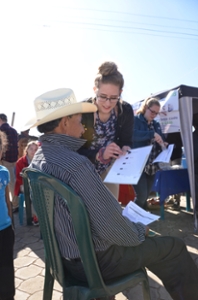Engineering in Guatemala


Chantal Monnier and Elena Arduin create
prototypes for food storage products
By Paige Smith
The Social Entrepreneurship in Guatemala winter term trip was unique for CEC. Fifteen CEC students—from all academic departments and grade levels—traveled to Guatemala to identify problems and develop unique engineering solutions. This trip was focused on personal growth, cultural understanding, and creative project development. No classes were taught there.
Using the social entrepreneurship model
My classmates and I went to Guatemala to work for a company called Solcom. Solcom was created by a Miami Alum, Greg Van Kirk, who also taught/is teaching the pre and post Guatemala classes.
Solcom works on the micro-consignment model. They train local entrepreneurs—mostly women—to go out into communities and sell products (like stoves, water filters, and solar lamps) and the women pay Solcom back only for what they sell and keep the profit for themselves. This model has many benefits—no financial risk for the entrepreneurs; it is sustainable because products are not being given away for free; and it avoids flooding the market with goods.
Identifying problems
As we learned in the one credit hour class we took in the fall semester, many technologies created for people in developing countries fail because the people who made them do not understand the problems they are trying to solve. We were encouraged to keep open minds as we traveled around southern Guatemala and to listen closely to the people we worked with and who we were aiming to serve.
In groups of three, we developed surveys and asked local people questions about their needs, desires, and future plans. By listening to what they had to say, we could begin to gage the perceived needs of the community, and what types of products they need to accomplish their goals.

Maddie Spurlock and Cameron Burgess test the
strength of our stove wing design
Engineering solutions
There were four engineering projects:
- Redesigning a cook stove for increased portability
- Designing an app to track community needs via survey results
- Creating a water catchment and storage system
- Identifying a better food storage system
We were limited by time, money, and resources. We had one week, less than $100 (to be shared between the four groups), no access to Amazon or mail services, and very low-speed WiFi (which was particularly troubling to the app group). In addition, none of the locals spoke English, so all interactions with the locals were done in Spanish.
I was in the stove group. We were told that we should make the stoves more portable. They weigh over 200 lbs, so the obvious idea is to make them smaller and lighter. However, making them smaller is not a good idea for a few reasons. First, Guatemalans cook on wood burning stoves because they eat a lot of tortillas (about four per person per meal) and tortillas made on a gas stove are taste bad. Wood is sold in large pieces, and require a large stove to burn large pieces of wood. In addition, a lot of surface space is necessary, because women in Guatemala cook many things at once—beans, meat, tortillas, coffee, etc.—and need to have multiple burners. A small camping stove is not a marketable solution.

Emily Hanson gives eye exams
In Guatemala, there is no mail service. Solcom transports their stoves in the backs of pick-up trucks or minibuses. The stoves, as they were originally designed, took up a lot of space, and a big component of Solcom’s costs (and therefore the ultimate cost to the consumer) are shipping costs. Therefore, my team decided that making it possible to ship more stoves in one truck would by the best use of our time. We designed removable wings and legs for the stoves, so that the stoves can be taken apart and stacked for shipping. Once bought, families can take their stoves apart if they ever need to move them.
Growing as engineers and people
For many engineers, in school and in industry, a problem is defined and a solution is formulated before the work even starts. For us, we did our own market research; we sourced our own materials and created our own budgets; and we worked with local craftsmen and entrepreneurs to help us create solutions in a country that we were unfamiliar with. I had never done a project before that was so extremely self-reliant.
Due to the extreme lack of resources, my team was constantly simplifying our ideas, and honestly, I think we developed a very, very good design because of it. Our design required very few parts and very little additional labor to create, yet it doubled the amount of stoves that could be shipped at once. Solcom loved it and plans to present the design to Deloitte consultants who will visit them in a few months. The other teams also had unique challenges and triumphs, and the work they have done will help Solcom better improve the lives of the people in the Guatemalan communities they serve.

